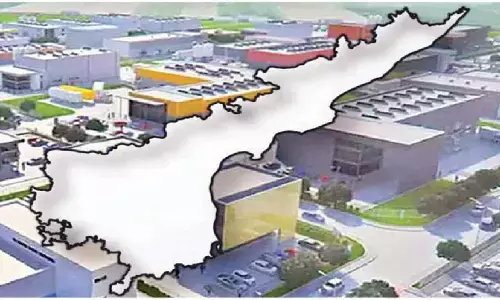Govt's high capex boost for infra can revive corporate lending: UCO Bank

Soma Sankara Prasad, MD & CEO, UCO Bank
The Kolkata-based bank plans to open 200 new branches across the country in a year UCO Bank has more than 3,000 branches all over the country and it is going to open 200 new branches in a year.
The Kolkata-based bank plans to open 200 new branches across the country in a year UCO Bank has more than 3,000 branches all over the country and it is going to open 200 new branches in a year. Among them, 20 branches will be opened in Telangana and Andhra Pradesh. Over 22,000 employees and 4,000 banking correspondents are currently working for the 79-year-old bank.
In an exclusive interview with Bizz Buzz, Soma Sankara Prasad, MD & CEO of UCO Bank, tells about his views on Russia-Ukraine war impact on Indian economy, the non-performing assets (NPAs) at public-sector banks, and revival in the demand for corporate term loans.
What is your take on the Indian economy? Do you see any impact of the Russia-Ukraine crisis on our country's financial position?
India is coming out of Covid-19 crisis, which has been handled very well in the country. We are back to normal and hopefully it shall come to an end with the third wave. There is an impact of Russia-Ukraine war on our economy, but it is for a short term. With depreciating rupee value, current account deficit is expected to widen. As the fuel prices are increasing day-by-day, obviously it will lead to inflation.
During initial days of the battle, the oil prices have gone up to $120-130 per barrel. But subsequently we noticed that the prices are coming down. Once the conflict ends, the fuel prices are likely to be normal. Looking at the conservative Union Budget 2022-23, I feel that the country will easily overshoot 10-20 per cent in tax collections. This will cushion whatever impact is there in the country due to fuel prices.
Except for a short term burden of higher fuel prices, I don't see any major blow to Indian economy because of the Russia-Ukraine crisis.
What is the expected GDP growth this fiscal and FY23?
Post pandemic period, Indian economy has picked up and it is doing well. As per the estimates given, the GDP growth is targeted to reach somewhere around 8.5-9.2 per cent this financial year and next year also it is pegged to achieve about 7.5-8.3 per cent. Whatever is the situation, our country is the fastest growing economy in the world.
Do you think RBI shall hike key rates to check inflation?
The RBI has projected that inflation by the end of March 2023 also will not cross six per cent, which is a comfort level for the Central bank. The repo rate is increased to curb the demand. If inflation is because of excess demand, the rise in repo rate will work. If it is a supply chain constraint, that can't be solved by repo rate hike. I feel that the RBI will be able to hold the rates because the present priority is growth.
The RBI may not consider increasing the key rates unless the inflation goes beyond out of control (above 6%). It will hold the rates to the extent possible. All major economies like US Federal Reserve raising interest rates will work. Even if the RBI increases the rates, the hike will come later. It will shift its accommodative stance to neutral. Probably, it will gradually revise the rates by next financial year.
What are the challenges being faced by public-sector banks? Do you see privatisation as a threat for public money?
The public-sector banks are now well capitalised, the NPAs are under control and their provision coverage ratio is also good. So, they are placed very well in terms of growth. The government doesn't want to maintain its presence in all the areas. In banking, their presence will always be there. As the government will privatise three banks, the number of public sector banks will be decreased from 12 to 9.
I don't think privatisation would provide a challenge to public sector banks. It will only help in providing quality services to the customers.
Do you see revival in corporate lending?
As announced in the Union Budget, government is doing all the heavy lifting. With this, there will be increased spending on the highway and infrastructure projects. Once it starts happening, there will be a multiplier effect on the economy. This is likely to revive the demand for corporate term loans. This will also create more employment opportunities in various sectors. Going forward, private investments are also expected to pick up from September onwards.
How NPAs are affecting the public sector banks? Will NPAs come down in near future?
Generally, NPAs means the banks stop earning interest income from that asset. There must be up to 100 per cent provision, which will drag down the profitability of the banks. Management bandwidth, the management' focus on main banking business, will be diluted due to concentration on NPA recovery. The NPAs at public-sector banks has seen its peaks during Covid times.
As the impact of third wave is lesser, there was no further surge in the NPAs. Moreover, the government has created Bad Bank, where some of the NPAs can be transferred and handled. Also, the corporate insolvency resolution process helps the banks to recover the NPAs faster and these stressed assets at public sector banks should come down with these efforts.
What is your take on cryptocurrency? Should India ban it?
There can only be one legal tender. RBI also wants to go for Central Bank Digital Currency (CBDC). There are a lot of risks involved in trading cryptocurrencies as they are speculative, and unregulated by unregulated any government or central bank. Several rural investors have reportedly faced huge losses due to lack of trading knowledge and volatility.
Also, there were many crypto fraud cases being reported across the globe. A cryptocurrency can never be a medium of exchange and it doesn't have a store of value. It doesn't have any characteristic of a normal currency. The government should look at it as cryptocurrencies may also be a new means of committing fraud, money laundering, and terrorism. If the government cannot manage cryptocurrencies, it shall ban them.
The government announced 30 per cent tax on virtual digital assets. Will it check investments in cryptocurrencies?
To a certain extent, this taxation will definitely discourage the trading of cryptocurrencies. It doesn't mean that the government will not regulate that. They may take a call on regulation of digital currency at a later date.
How UCO bank is doing this financial year?
UCO Bank was placed under Prompt Corrective Action (PCA) framework in 2017 due to its deteriorating financial health and it was focusing on the recovery. After coming out of the PCA in August 2021, it has been concentrating on the growth and expansion. The bank has been earning profits for the past few quarters. It has reported a profit of more than Rs100 crore by the end of June 2021.
The bank has posted a profit of Rs200 crore by the end of September 2021 and Rs310 crore by the end of December 2021. It has a capital adequacy ratio of 14.56 per cent, while the Reserve Bank of India (RBI) prescription is 11.5 per cent. So, it would not require fresh capital for the next one-and-half years. Its provisioning Coverage Ratio (PCR) is the second highest among all the banks at 91.3 per cent.
The bank would also advance loans for the purchase of assets under the National Asset Monetisation Programme (NAMP) of the Government of India. The bank's main focus was on RAM sectors – Retail loans like home loans, Agriculture loans and Micro, Small & Medium Enterprises (MSME) loans, where the NPAs would be lesser.
What are the plans for next fiscal? Are you going to expand the network?
The bank has more than 3,000 branches all over the country and it is going to open 200 new branches in a year. Among them, 20 branches will be opened in Telangana and Andhra Pradesh. The new branches shall achieve breakeven within one-and-half years of setting up.
Over 22,000 employees and 4,000 banking correspondents are currently working for UCO Bank across India. We will soon hire 820 people all over India. Out of them, 350 persons will be deployed at the new branches and the remaining 470 will be working at field operations. The bank has the youngest workforce with an average age of 35 years.

















